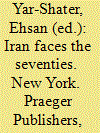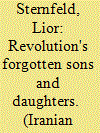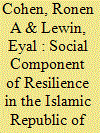| Srl | Item |
| 1 |
ID:
118579


|
|
|
|
|
| Publication |
2012.
|
| Summary/Abstract |
Iran's historical flirtation with democracy has been one of thwarted desires. The 1906 Constitutional Revolution introduced the concepts of liberal democracy to Iranian society, but success was limited by the lack of support from the ulama (clergy). After decades of authoritarianism, under both the Pahlavi family and the ayatollahs, Iran has little experience with modern democratic institutions. It is the argument of the authors that without a fully formed civil society, the lack of progress toward democracy will be prolonged, unless the religious elite come to consider democracy to be in Iran's best interest. Given the seemingly domino-like effect of the Arab Spring, the ulama of Iran may not have much time before the push for democracy becomes an issue.
|
|
|
|
|
|
|
|
|
|
|
|
|
|
|
|
| 2 |
ID:
029253


|
|
|
|
|
| Publication |
New York, Praeger Publishers, 1971.
|
| Description |
xx, 391p.hbk
|
| Series |
Praeger Special Studies in International Economics and Development
|
|
|
|
|
|
|
|
|
|
|
|
Copies: C:1/I:0,R:0,Q:0
Circulation
| Accession# | Call# | Current Location | Status | Policy | Location |
| 010702 | 955/YAR 010702 | Main | On Shelf | General | |
|
|
|
|
| 3 |
ID:
134812


|
|
|
|
|
| Summary/Abstract |
The 1979 revolution in Iran was one of the most popular revolutions of the twentieth century. It was supported by all the classes of Iranian society, and crossed social strata, positions, and religious affiliations. A lot is known about the participation of different parts, such as students, urban professionals, religious leaders, bazaaris, and leftists, yet little is known about the participation of Jews in the revolutionary movements. This article sheds light on a little-known event in the life of the Jewish Iranian community and seeks to tell the story of different segments of the Jewish community during the tremulous years of the “Islamic Revolution.” This article examines two main arenas in which the Jews facilitated the revolution—the Society of Jewish Iranian Intellectuals, and the Sapir Charity Hospital in Tehran—and seeks to draw attention to the minorities' contribution to the most important national revolution in Iran.
|
|
|
|
|
|
|
|
|
|
|
|
|
|
|
|
| 4 |
ID:
174832


|
|
|
|
|
| Summary/Abstract |
This article examines the social components of national resilience as the source of the Islamic Republic of Iran’s ability to cope with possibly lethal blows and economic setbacks through four stages: (I) an account of the 1980–1988 Iran–Iraq War and the surprising outcome that left Iran undefeated, (II) a review of several theories that can aid us to analyze Iran’s national resilience ability, (III) an analysis of Iran’s wartime survival using the abovementioned theoretical infrastructure, (IV) a concise review of current issues in Iranian society which concludes with an evaluation of the state of Iran’s resilience regarding attacks on their nuclear program and its ramifications.
|
|
|
|
|
|
|
|
|
|
|
|
|
|
|
|